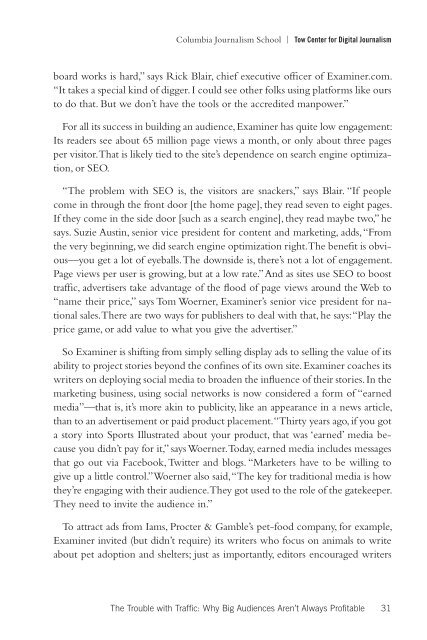What We Know About the Business of Digital Journalism
What We Know About the Business of Digital Journalism
What We Know About the Business of Digital Journalism
Create successful ePaper yourself
Turn your PDF publications into a flip-book with our unique Google optimized e-Paper software.
Columbia <strong>Journalism</strong> School | Tow Center for <strong>Digital</strong> <strong>Journalism</strong>board works is hard,” says Rick Blair, chief executive <strong>of</strong>ficer <strong>of</strong> Examiner.com.“It takes a special kind <strong>of</strong> digger. I could see o<strong>the</strong>r folks using platforms like oursto do that. But we don’t have <strong>the</strong> tools or <strong>the</strong> accredited manpower.”For all its success in building an audience, Examiner has quite low engagement:Its readers see about 65 million page views a month, or only about three pagesper visitor. That is likely tied to <strong>the</strong> site’s dependence on search engine optimization,or SEO.“The problem with SEO is, <strong>the</strong> visitors are snackers,” says Blair. “If peoplecome in through <strong>the</strong> front door [<strong>the</strong> home page], <strong>the</strong>y read seven to eight pages.If <strong>the</strong>y come in <strong>the</strong> side door [such as a search engine], <strong>the</strong>y read maybe two,” hesays. Suzie Austin, senior vice president for content and marketing, adds, “From<strong>the</strong> very beginning, we did search engine optimization right. The benefit is obvious—youget a lot <strong>of</strong> eyeballs. The downside is, <strong>the</strong>re’s not a lot <strong>of</strong> engagement.Page views per user is growing, but at a low rate.” And as sites use SEO to boosttraffic, advertisers take advantage <strong>of</strong> <strong>the</strong> flood <strong>of</strong> page views around <strong>the</strong> <strong>We</strong>b to“name <strong>the</strong>ir price,” says Tom Woerner, Examiner’s senior vice president for nationalsales. There are two ways for publishers to deal with that, he says: “Play <strong>the</strong>price game, or add value to what you give <strong>the</strong> advertiser.”So Examiner is shifting from simply selling display ads to selling <strong>the</strong> value <strong>of</strong> itsability to project stories beyond <strong>the</strong> confines <strong>of</strong> its own site. Examiner coaches itswriters on deploying social media to broaden <strong>the</strong> influence <strong>of</strong> <strong>the</strong>ir stories. In <strong>the</strong>marketing business, using social networks is now considered a form <strong>of</strong> “earnedmedia”—that is, it’s more akin to publicity, like an appearance in a news article,than to an advertisement or paid product placement. “Thirty years ago, if you gota story into Sports Illustrated about your product, that was ‘earned’ media becauseyou didn’t pay for it,” says Woerner. Today, earned media includes messagesthat go out via Facebook, Twitter and blogs. “Marketers have to be willing togive up a little control.” Woerner also said, “The key for traditional media is how<strong>the</strong>y’re engaging with <strong>the</strong>ir audience. They got used to <strong>the</strong> role <strong>of</strong> <strong>the</strong> gatekeeper.They need to invite <strong>the</strong> audience in.”To attract ads from Iams, Procter & Gamble’s pet-food company, for example,Examiner invited (but didn’t require) its writers who focus on animals to writeabout pet adoption and shelters; just as importantly, editors encouraged writersThe Trouble with Traffic: Why Big Audiences Aren’t Always Pr<strong>of</strong>itable 31
















